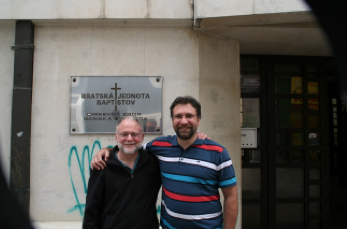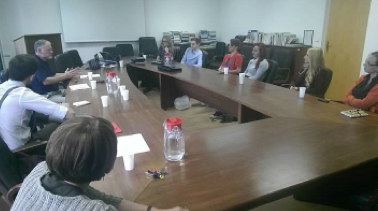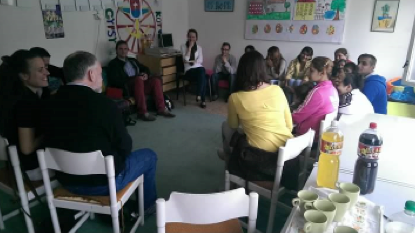Paul Sheridan is an active member of Not In Our Town from Charleston, WV. For many years, he was the head of the Civil Rights Division for the West Virginia Attorney General's Office, and has experience working for civil rights protection both in courts and at the community level.
In this piece, Sheridan describes his experience in Charleston's sister city, Banská Bystrica, Slovakia, and the work being done there to combat a reemergence of hatred and intolerance toward minorities.

Nie V Nasom Meste. Photo courtesy of Paul Sheridan.
I recently traveled to Banská Bystrica, Slovakia, the “sister city” to my hometown Charleston, West Virginia. For years the two cities have had a formal relationship which has included cultural exchanges of various kinds, with various delegations traveling in both directions. My recent visit added a new and different dimension to this sister city relationship. I was invited to Banská Bystrica by a coalition of community leaders there who are working to combat a rising tide of anti-Semitic and anti-Roma bigotry in the region and seeking to build a more inclusive community where they live.
‘When Bigoted Electoral Rhetoric Becomes the Norm’
In Slovakia last November, a neo-Nazi candidate running on a platform of addressing the problem of “Roma parasites” won an election to an executive post in the regional government for the area which includes Banská Bystrica. This election caused a shock wave in the region.
Community leaders in Banska Bystrica are acutely aware, as are students of the Holocaust everywhere, that it is extremely dangerous when bigoted electoral rhetoric becomes the norm. Banská Bystrica community leaders began searching for workable strategies to engage their city in resistance to intolerance.
Making the Connections
As part of the search, these leaders reached out to their “sister city” for ideas about what forms of community action had worked to resist bigotry in the United States.
In previous conversations with Slovaks visiting Charleston, I had heard of the problem of discrimination confronting Roma people in their county. The Roma are a distinct cultural sub-group in many Eastern European countries, more familiar to Americans by the term “gypsies.” For some time, there have been growing indications of anti-Roma and anti-Jewish bigotry in Slovakia. Because it related to my own work, I had expressed interest in the parallels between the Roma experience in Slovakia and the African-American experience in the United States.
For many years I led the Civil Rights Division of the West Virginia Attorney General’s Office. I have also been active with Not In Our Town (NIOT), which focuses on promoting and supporting effective local efforts to resist bigotry. NIOT strategies are based on the premise that ordinary citizens can (and inevitably do) play an important role in determining whether (or not) a community is inclusive and tolerant of its diversity.

of Not In Our Town. Photo Courtesy of Paul Sheridan
NIOT strategies have been employed successfully in Charleston. For example, Charleston has regularly hosted interfaith events, at which people from different faith traditions give voice to a common commitment to end hate and violence. And when hate groups have come to Charleston to picket and peddle their hate, citizens have organized counter-message events which peacefully upstaged the bigots and made clear to all who were watching that most Charlestonians desire and actively work for equality and inclusion.
Banská Bystrica leaders invited me there in the spring of 2014 to talk about community-based strategies to reduce intolerance.
Cross-Community Conversations
Over the course of two weeks I met with the coalition partners and others, and had dozens of conversations about possibilities for positive civic engagement. I met with NGO representatives, business leaders, church leaders and government officials who are all seeking to resist the resurging intolerance. I also met with various groups of citizens, including Roma and student groups.
At many gatherings I shared a PBS documentary entitled Not In Our Town, which tells the story of how the American town of Billings, Montana effectively resisted white supremacist activity through civic engagement (We had Slovak subtitles written for the documentary.) And at every opportunity I described community-based strategies which have been successfully employed in West Virginia.
While in Slovakia I also met with representatives from the U.S. Embassy, who encouraged this sister city effort. It was apparent that they shared a concern about the election of a neo-Nazi and what it might mean for Slovakia. The Embassy helped secure a translator, which facilitated my visit, and promised additional financial support for the coalition in Banská Bystrica.
Faced with the Danger of Remaining Silent, Banská Bystrica Speaks Out
"I was very encouraged by the community leaders in Banská Bystrica. They clearly recognize the danger of remaining silent, and I am confident that they will continue to speak out. They are also committed to building a movement, by bringing together many sectors of the community into the effort, so that their collective voices will shape the climate in Banská Bystrica and inspire other communities in the region to do likewise."
While I was in Banská Bystrica, I learned that the extremist rhetoric is directed largely at Roma and Jews, and to a lesser extent against Hungarians, and plays on deep-seated prejudices and stereotypes. The prejudices and stereotypes are pervasive, and some Slovak attitudes toward Roma are reminiscent of the attitudes of White Americans toward Black Americans prior to the Civil Rights Movement. The extremism also plays on widespread frustration over the economy and dissatisfaction with the European Union, and channels the frustration into a form of nationalism which is explicitly and unapologetically reminiscent of and sentimental for the 1940s.
Needless to say, it is a scary situation, with potential to get worse, and accordingly it is very important that people of good will in the region actively speak out. I also learned that the challenge of organizing citizen action in Slovakia is complicated by a national experience which makes folks especially leery of speaking out or standing up. Citizen action had not been a feature of Slovak life during the period of domination by the Soviet Union. Most Slovaks are wary of standing out, much less speaking up, and although this is changing, it is changing slowly.
However, I was very encouraged by the community leaders in Banská Bystrica. They clearly recognize the danger of remaining silent, and I am confident that they will continue to speak out. They are also committed to building a movement, by bringing together many sectors of the community into the effort, so that their collective voices will shape the climate in Banská Bystrica and inspire other communities in the region to do likewise.
Building on the NIOT story of Billings, Montana (and on the movement that it spawned in the United States), the coalition in Banská Bystrica has adopted the name Nie V Nasom Meste—Not In Our Town. While I was there, they issued a statement of principles along with an invitation to community members to sign on. Within a few days they dozens of signatures, including that of the mayor, and I am told that the level of participation continues to grow.
Neighbors: Banská Bystrica and Charleston
It has been famously said that history repeats itself. This possibility is very much on the mind of Alica Frühwaldová, a Banská Bystrica citizen whose Jewish family was decimated in the Holocaust. As she explained to reporters, with the election of a neo-Nazi she saw a familiar pattern unfolding, and she stepped forward “without hesitation” to become a leader of Nie V Nastom Meste. Clearly she believes that tragedies can be avoided and a different history written when people find the compassion and the courage to act as neighbors.
Nie V Nasom Meste is built on this simple but powerful idea, that healthy communities consist of neighbors standing up for neighbors. In Banská Bystrica, neighbors are beginning to stand up for each other, especially for those who are most vulnerable.

Bystrica. Photo Courtesy of Paul Sheridan
The community of Banská Bystrica has looked to its neighbors in Charleston, West Virginia for inspiration and support. We in turn can be comforted by their efforts to resist bigotry and extremism, and we can feel honored and affirmed by their imitation of some of our approaches. In addition, we can take inspiration from our Slovak sister city, to work harder in our own communities to ensure that they are truly inclusive.
| Attachment | Size |
|---|---|
| 22.5 KB |
Add new comment